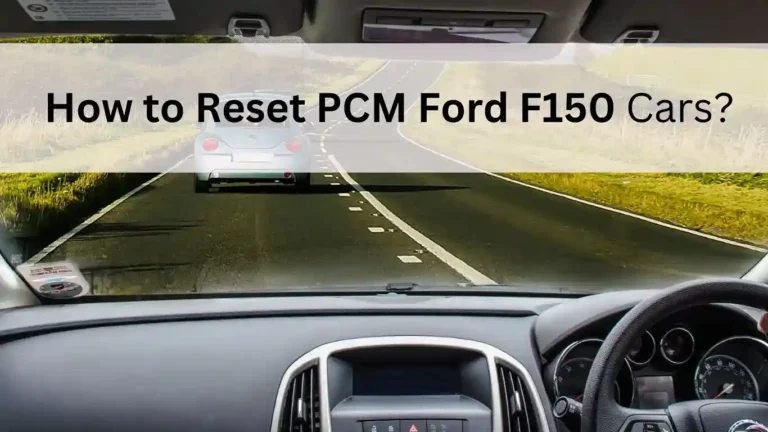I totally get how frustrating it is when you’re all set for a drive, and your car just decides it’s not going to start, talk about bad timing! But let’s take a moment and find out why a ford f150 wont start and then try to fix things.
Well, there could be several reasons for your F150 to not start. The faulty starter, fuses, battery, fuel pump or pressure regulator, EVAP valve, or even the Neutral Safety Switch can cause this kind of issue. To fix it, you’ll need to change the bad parts.
But hey, don’t get disheartened as I’ll help you on this journey! In this guide, I’ll dive deep into why your Ford F150 is acting up and give you a clear guide on how to fix it. Let’s Get into It!
Table of Contents
Why Your Ford F150 Wont Start and How to Fix It?
there could be several reasons why your F150 is refusing to start. Let me explain them and provide solutions to help you fix the problem on your own:
| Causes | Repairs |
| Damaged starter/solenoid | Change the starter/solenoid |
| Burnt fuses | Replace the fuses |
| Battery is dead | Change the battery |
| Bad fuel pump or pressure regulator | Replace a new fuel pump/pressure regulator |
| Faulty EVAP valve | Change the EVAP valve |
| Damaged Neutral Safety Switch | Replace the Neutral Safety Switch |
1. Bad Starter Part
The first reason for your car to not start is none but the faulty starter or solenoid part. When it fails, the F150 wont start and stops cranking as well.
To confirm it, you can jump-start your F150 and see if the car makes an engine crank sound. If your F150 turning over but not starting, it indicates other issues which you can know by checking this guide.
But if your car doesn’t make any noise when you try to start it, that means there’s a problem with the starter. According to Repair Pal, about 15% of the time when cars won’t start, it’s because of a bad starter. You can get your car running again by replacing the starter.
How to Fix?
- You’ll need to open the hood of your car and locate the battery. Then, detach the black negative (-) terminal of the battery and place a towel to prevent electrical interaction with other parts.
- Next, put on the jack pads and stands to lift the car upward. That way you can get underneath the car to find the starter. Usually, the starter is located on the passenger side’s transmission bell housing area.
- Once you find the starter part, use a 13mm socket to remove 4 nuts and disconnect the 4 wires. Then, insert an extender (6”) on the standard socket wrench to easily detach the other bolts that hold the starter.
- After that, detach the old starter and insert the new one. If taking out the old starter seems hard, use WD40 lubricant and let it be there for 30 minutes to easily remove the part.
- Then, reinstall all the parts and close the hood.
Repair Cost: $400 – $800 or more (for the part and the labor).
Duration: 60 – 120 minutes.
2. Blown Out Fuses
Sometimes, when the fuses get blown out, your 1993 – 2023 Ford F150 won’t start, even if it seems to be trying. The starter, starter relay, fuel pump relay, and PCM power relay fuses play a great role in starting your car.
If you notice that the Theft light is blinking and your F150 wont start, one of the common reasons is these damaged fuses.
To make sure your car starts without a hitch, you should take a close look at these fuses and put in new ones if needed.
How to Fix?
- Open the hood of your F150 and locate the engine compartment fuse box. Then, remove the lid from the engine compartment fuse box.
- Next, find the starter, starter relay, and PCM power relay fuses from the fuse box. After that, remove them and check for burnt marks.
- If the fuses contain brown or melting marks, then remove them and install new ones. Then, test it out.
Repair Cost: $20 – $100 or above (for parts and labor costs).
Duration: 20 – 30 minutes.
3. Dead Battery
Another reason why your car might not start is because the battery could be dead or not charging properly. This can also lead to your F150 not starting and not making any clicking sound issues.

To check if the battery is the problem, you can use a tool called a multimeter to measure the voltage. The voltage should be higher than 12 volts (ideally 12.60 volts).
If the reading is below 12 volts, it means there’s a problem with the battery. To solve this issue, you’ll need to replace the old battery with a new one.
How to Fix?
- To begin with, open the hood of your car and then test out the voltage using the multimeter. Be sure to put the multimeter to DC voltage. Also, place the red lead on the red terminal of the battery while the black lead on the black terminal of the battery.
- Once you’ve read the voltage of the battery and confirmed that there’s an issue with the battery, detach the black negative (-) and red terminal (+) terminals. For that, detach the nut using the socket wrench.
- Next, take out the battery cables and detach the bolts of the battery using a socket wrench.
- After that, remove the old battery and install a new one. Then, reinstall all the parts to finish the process. Be sure to reset the BMS or your F150 won’t start after replacing the battery. To understand it better, read this guide!
Repair Cost: $450 – $1,050 or above (for parts, resetting BMS, and the rest for labor).
Duration: 60 minutes.
4. Faulty Fuel Pump and Pressure Regulator
When your F150 won’t start in cold weather, it usually means there’s a problem with either the fuel pump or the pressure regulator.
In winter, your car may take a long time to start, and it might even show the F150 intermittent starting issues.
Based on Get Jerry, the car’s gauge can flicker due to insufficient power of the battery. To fix this, you’ll need to replace the damaged fuel pump and the pressure regulator.
How to Fix?
- Start by opening the hood of your car and locate the fuel pressure regulator. It is usually on the fuel rail on the driver’s side of the engine (inside the hood).
- Then, detach the vacuum line and then remove the snap ring with the help of snap ring pliers. Afterward, take out the old fuel pressure regulator and install a new one.
- Now, jack up your car using a transmission jack stand that helps to lift the fuel tank’s big component easily. Then, find the fuel lines and squeeze the plastic tabs to disconnect the lines. After that, take out the fuel line with a red clip using a flat screwdriver.
- Next, use a 13mm socket wrench to remove the bolts that hold the fuel tank’s huge component (black in shade). Then, take out the metal strap that holds the part.
- Afterward, slowly lift the fuel tank housing downward by removing the retainer shield nuts. Next, detach the filler neck with a 7mm socket wrench and take out the hose clamp. For that, use a flat screwdriver to detach the filler neck.
- Then, you’ll need to track the small hose and detach it by pressing the clips. After that, grab the same flat screwdriver to pry the locking tab out. That way you can detach the plugs which are linked to the fuel tank.
- Next, lift the fuel tank’s part and use some WD40 lubricant on the metal ring above the surface. Then, wait for 30 minutes so that it loosens up a bit to remove the metal ring.
- After this, rotate the metal ring on the fuel tank to lower the tank and then detach the connectors above. Then, install a new fuel tank and reinstall all the removed parts.
Repair Cost: $850 – $1,600 or above (for the parts, diagnosis, testing, and labor).
Duration: 180 minutes.
5. Issue with EVAP Valve
In case your F150 won’t start after fueling the gas tank, it might be occurring due to a faulty EVAP (Evaporative Emission Purge) valve. This thing lets fuel vapors go back to the engine when the PCM activates.
It needs to be closed when the key is turned off. But, if it fails to operate properly, it can cause the F150 to not start. To repair it, you’ll need to replace the EVAP valve with a new one.
How to Fix?
- To start with, open the front trunk of your F150 and locate the EVAP valve. Usually, it is located under the hood above the engine.
- Then, detach the black negative (-) terminal clamp of your F150 and put it on a towel.
- Next, disconnect the electrical connector that is attached to the purge valve.
- After that, use an 8mm socket and take out the 2 bolts that are holding the EVAP valve.
- Once it’s done, remove the old EVAP valve and install a new one. Afterward, reinstall all the removed parts.
Repair Cost: $250 – $300 or above (for the parts, diagnosis, testing, and labor).
Duration: 15 – 30 minutes.
6. Bad Neutral Safety Switch
The main problem when your F150 won’t start in Park or Neutral is often a faulty Neutral Safety Switch. This part is crucial because it prevents the engine from starting when your gear isn’t in Park or Neutral.
You can tell the switch is bad if your car won’t start in one of these positions or if the engine doesn’t make any noise when you try to start it. In that situation, you should replace this part to fix the issue.
How to Fix?
- To begin with, lift your truck with a transmission jack or usual jack stands. After that, get under the truck and locate the Neutral Safety Switch part. It’s mostly located on the transmission (driver-side).
- Then, unplug the electrical connector from the switch part with a flat screwdriver.
- Next, use a basic wrench to detach the middle bolt (big one) with a little force. If it doesn’t rotate, use lubricant and leave it for 30 minutes. Then, detach the metal loop part.
- Once it’s removed, grab a socket wrench to detach the 2 bolts that hold the switch. Then, remove the old Neutral Safety Switch using the metal pry tool or flat screwdriver.
- Afterward, install the new one and reinstall all the parts.
Repair Cost: $150 – $400 or above (for the part and labor).
Duration: 15 – 30 minutes.
Note: In rare cases, the failing transmission oil pump can cause your F150 Auto Start/Stop not to work. Make sure to check this guide and know the solutions.
Ending Notes
Dealing with a Ford F150 that won’t start can be really frustrating, especially when you need your car. It can be quite a task to figure out what’s wrong and replace the necessary parts. But having a scan tool can make this job much easier.
I hope you find this guide helpful in identifying the issues and that you’re able to make the fixes at home. Good Luck with this project!
And while you’re at it, don’t forget to check out our guide for quick solutions if your F150’s Auto Start/Stop feature isn’t working right or acting strangely. Enjoy the read!




